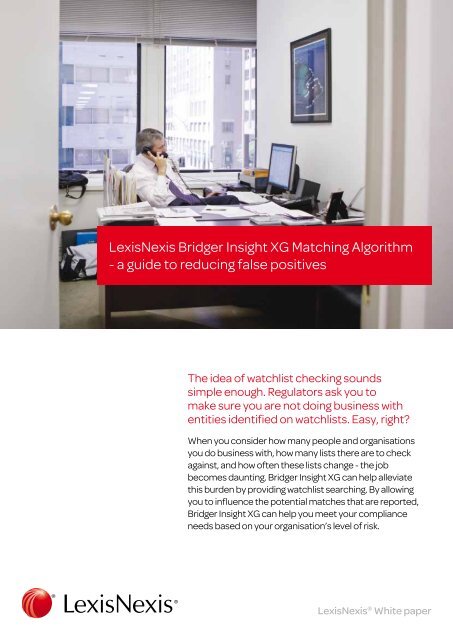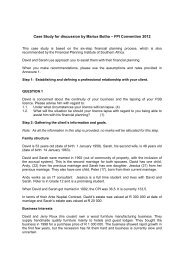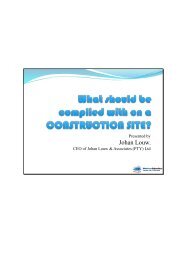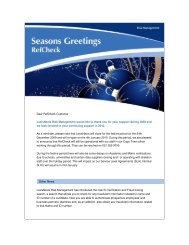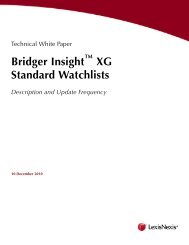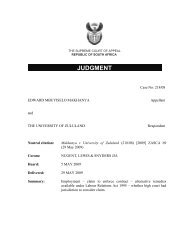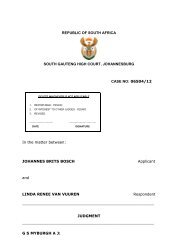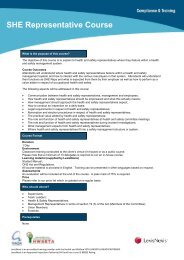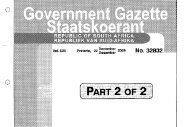LexisNexis Bridger Insight XG Matching Algorithm - a guide to ...
LexisNexis Bridger Insight XG Matching Algorithm - a guide to ...
LexisNexis Bridger Insight XG Matching Algorithm - a guide to ...
Create successful ePaper yourself
Turn your PDF publications into a flip-book with our unique Google optimized e-Paper software.
Unicode and NormalisationWhy is Unicode important? Unicode allows users <strong>to</strong> compareentity data in all supported alphabets. It also allows <strong>Bridger</strong><strong>Insight</strong> <strong>XG</strong> <strong>to</strong> normalise comparison information <strong>to</strong> standardiseinput text, so it can be more reliably and accurately compared.<strong>Bridger</strong> <strong>Insight</strong> <strong>XG</strong> performs normalisation with no appreciableloss of processing speed.For example with normalisation, spelling variations in thenames Chloë and Chloé would both become CHLOE, whichwould allow for more accurate matching.Normalisation also works with alphabets other than Latin. Forexample with Arabic normalisation, the initial, middle, and endforms of letters are all converted <strong>to</strong> the isolated form. So thename “Jamal”— becomes with normalisation.While normalisation is used for comparison purposes with<strong>Bridger</strong> <strong>Insight</strong> <strong>XG</strong>, reported results are not normalised.Watchlist entries and input data are provided in the results asthey were originally entered.Nicknames and Word VariationsTo identify name variations, <strong>Bridger</strong> <strong>Insight</strong> <strong>XG</strong> comparesthe input <strong>to</strong> an internal file of nicknames, abbreviations, andanglicised words. Currently, the extensive file lists mostlyLatin-based variations. This file is dynamic, however, allowing<strong>LexisNexis</strong> Risk Solutions <strong>to</strong> continually add name variations.False Positive ReductionThe <strong>Bridger</strong> <strong>Insight</strong> <strong>XG</strong> matching algorithm can eliminate a largenumber of false positives from being reported as potentialmatches. False positives are potential matches in which the inputinformation is similar <strong>to</strong> the data contained in a watchlist, but theinput entity is not actually the watchlist entity.When searching input information against watchlists, <strong>Bridger</strong><strong>Insight</strong> <strong>XG</strong> fac<strong>to</strong>rs in frequent causes of false positives suchas missing or initialised last names and common words. Likename variations, the matching algorithm compares the inputinformation against an internal file of common words. <strong>Bridger</strong><strong>Insight</strong> <strong>XG</strong> weights common words lower than more unique words.Missing/Initialised Last Name ExamplesWatchlist EntityLikely MatchThomas Jeffry MadisonThomas MadisonUnlikely/Low Match Thomas Jeffry, Thomas M.Common Term ExamplesWatchlist EntityLikely MatchUnlikely/Low MatchBird Bath Fac<strong>to</strong>ryBird Bath CompanyBubble Bath Fac<strong>to</strong>ryScoring ResultsAll potential matches are assigned a confidence score. The confidence score is not a percentage, but an indica<strong>to</strong>r of how closelyyour input information matches a watchlist entity. This score can range from 0 (low) <strong>to</strong> 100 (high).Score GeneralisationsScore Range Description100 Exact Match of Data Elements Considered99-95 Highly Likely Match94-90 Very Good Match89-85 Good Match84-80 Less Likely Match79-75 Weak Match74-0 Unlikely MatchA score of 100, for example, does not mean thatyour input entity is the watchlist entity. It meanssome of the input information matches watchlistentity information, and you may want <strong>to</strong> furtherexamine the alert <strong>to</strong> determine next steps <strong>to</strong> take ifany. Only potential matches that meet the minimumscore threshold defined by you for the watchlist arereported. You set this minimum score threshold foreach watchlist searched.Minimum score exampleYou set the watchlist minimum score <strong>to</strong> 80. When you search your input information, <strong>Bridger</strong> <strong>Insight</strong> <strong>XG</strong> finds potential matches withconfidence scores of 65, 72, 77, 89, 95. <strong>Bridger</strong> <strong>Insight</strong> <strong>XG</strong> only reports the two matches with scores above 80.
SummaryThe quantity and complexity of data encountered duringwatchlist checking makes a powerful search <strong>to</strong>ol vitally importantin lessening your manual workload and helping ensure relevantmatches are found. This need is compounded by the legal,financial, and reputational consequences your organisation mayexperience if you are found doing business, even unwittingly,with barred entities. <strong>Bridger</strong> <strong>Insight</strong> <strong>XG</strong> can help alleviate thisburden by providing watchlist searching that features a matchingalgorithm that systematically resolves many of these data issues.By allowing you <strong>to</strong> influence the potential matches that arereported, <strong>Bridger</strong> <strong>Insight</strong> <strong>XG</strong> can be used <strong>to</strong> help you meet yourcompliance needs based on your organisation’s level of risk. Thisconfigurability may save you time and resources while allowingyou <strong>to</strong> efficiently address compliance requirements and protectyour organisation’s reputation.Trust <strong>LexisNexis</strong> <strong>to</strong> protect your business<strong>LexisNexis</strong> has a world-class reputation for providingprofessional firms with critical business <strong>to</strong>ols. For over 30 yearswe have been pioneers in risk management and intelligence.Our solutions are used internationally by financial services,legal and accountancy firms and blue chip multinationalcompanies, including the world’s <strong>to</strong>p 5 banks, <strong>to</strong> enhancebusiness decision making, reduce the cost of compliance,fulfil regula<strong>to</strong>ry requirements and prevent money laundering.Access all the South African and global news, company andindividual information, sanctions, PEP and watchlists you needfor cost-effective and efficient client and third party screening,enhanced due diligence and media moni<strong>to</strong>ring.Efficiently address compliancerequirements and protect yourorganisation’s reputation.Get in <strong>to</strong>uchTo find out more about <strong>LexisNexis</strong> <strong>Bridger</strong> <strong>Insight</strong> and how <strong>LexisNexis</strong> can help your business:+27(11)245 6539/41/45/61 | ios@lexisnexis.co.za | www.lexisnexis.co.za


